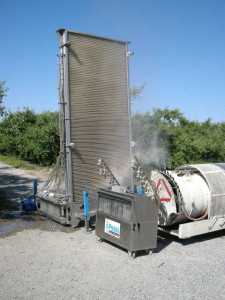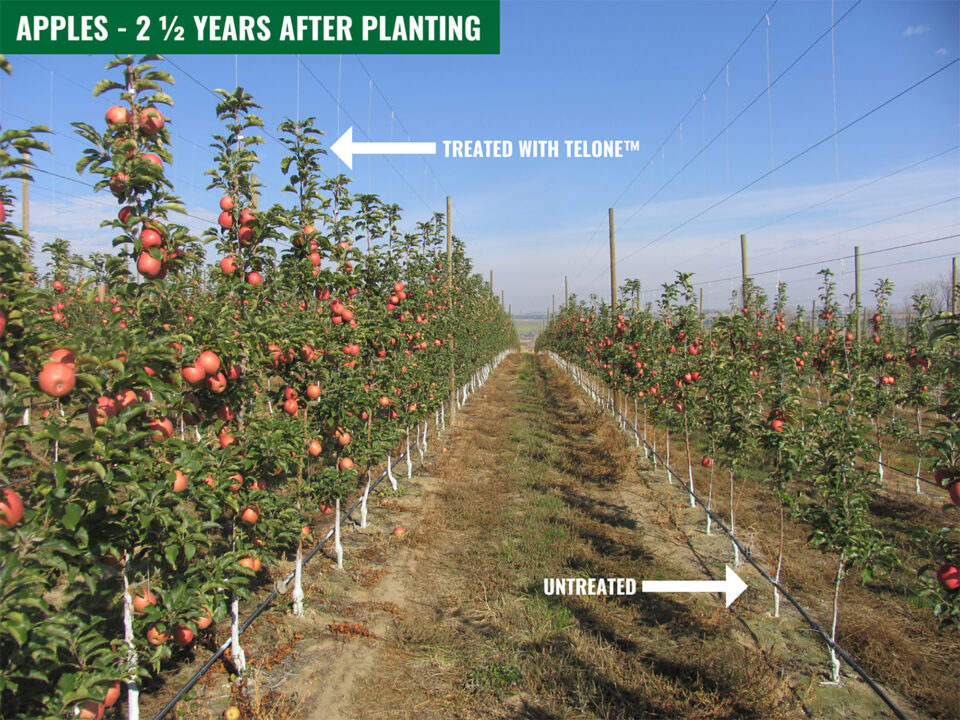Practical Steps To Improving Sprayer Performance

A patternator is a series of vertical collecting devices connected to hoses and then tubes. When you spray the patternator, it will collect and run into the tubes so that you can see your vertical spray distribution
Improving the efficiency of their sprayers should be a goal for every fruit grower, according to Gwen Hoheisel of Washington State University Extension in Prosser, WA. “It’s all about getting every drop to the crop.”
According to Hoheisel, there are three areas growers can focus on where easy, practical changes can be made to improve sprayer performance: hitting the target, covering the target, and putting the right amount on the target. All it should take is attention to detail and making the appropriate adjustments when necessary.
Hitting The Target
Controlling air flow can go a long way, says Hoheisel. “If you can control the air, you can control the droplets in the air.” The job of air flow is to make sure the droplets get from the machine to the target. However, this is not always practical given that not all trees are the same size, and in many cases growers might be spraying early in the season, when there’s less canopy.
The easiest solution is to adjust the air flow to better match the density of the canopy. This can be done a couple different ways, including adjusting fan speed at the gear box. You can also apply a plywood donut. “This works the same way as a dial on a wood burning stove or a charcoal grill,” says Hoheisel. “Air is taken in at the back of the fan, and by reducing the size of area for air intake, there is less volume of air to push out. This is particularly good for early season applications where you don’t have to penetrate a lot of canopy to hit the target.”
If a sprayer’s vertical spray pattern doesn’t match the canopy, you can also look at the deposit and adjust accordingly. The easiest way to do this is with a device called a patternator. “A patternator is a series of vertical collecting devices connected to hoses and then tubes. The idea is that when you spray the patternator, it will collect and run into the tubes so that you can see your vertical spray distribution,” says Hoheisel. “The vertical spray pattern should be similar to the shape of your canopy. It will not predict how much coverage you have on an individual leaf, but rather the pattern of spray in specific areas of the canopy.”
Hoheisel worked with 20 growers in Washington on using the patternator, and the results were revealing, as testing indicated that none of them were positioning their sprayers to match their canopy shape. “This is why it’s so important to change the direction of the air, so you can change the deposition of the droplets,” says Hoheisel.
Growers can actually build a patternator themselves, says Hoheisel. Dr. Andrew Landers with Cornell University has building plans on his Pesticide Application Technology webpage (http://web.entomology.cornell.edu/landers/pestapp/).
Covering The Target
The droplet size is critical in covering the target effectively, says Hoheisel. “The goal is to apply many small droplets that will stick to the entire leaf surface.” There are three factors that will affect this deposition: pressure, nozzles, and speed of the sprayer.
While air flow controls where you place the drops, pressure from the sprayer tank controls flow rate and droplet size. High pressure will result in fine droplets, while low pressure will result in coarse droplets.
The key for growers is to make sure they have a pressure gauge that is working properly. A bad pressure gauge will have a needle that bounces or does not return to 0. “It’s important for growers to test their pressure gauges annually, and replace them if necessary.”
The droplet size and volume coming from the nozzle is also important. Too high volume can lead to runoff, while volume that is too low can lead to poor coverage.
Different hole sizes and nozzle types will give different droplet sizes and spray patterns. The problem, says Hoheisel, lies in clogging. “Nozzles clog for many reasons, such as bad
filters or poor agitation.” You can ensure good agitation by having one-third of your pump capacity denoted just for agitation, which will help ensure that your pump is adequately mixing the solution. It’s also important to clean filters frequently. Develop a maintenance plan through the season that is simple, quick, and easy to communicate to other workers. For example, make it standard to check the nozzles and filters every five sprays or other practical interval.
The Right Amount
Applying the correct amount of material to the leaf surface will help maintain spray quality, says Hoheisel. This includes the chemicals’ half life, which will vary depending on active ingredient and pH. “Half-life is the time taken for half the amount of material to degrade or become inactive,” says Hoheisel. “The pH of water dramatically affects the period of activity for chemicals. Too high a pH and the half life is very short, too low a pH and there could be issues with maximum residue levels.”
Sprayer calibration is very important, and failure to calibrate leads to wasted product. For example, a 16-nozzle airblast sprayer may spray a product that costs $60 per acre. Once the nozzle tips wear down by up to 20%, about $12 per acre in extra material may be applied. New nozzle tips or gaskets may be an extra up-front expense, but they should pay for themselves quickly.
Frequent recalibration is also important, as a one-time calibration will only work for the current equipment and conditions. Any changes to nozzles, etc., mean it’s time to recalibrate. In other words, plan on doing so at least once a year.
The bottom line, says Hoheisel, is that maintaining the performance of your sprayer begins and ends with having the right data. “We track a high amount of data in horticulture, but when it comes to sprayers, we don’t often collect enough data.”
Advice On Calibration (And Other Good Resources)
There are a number of YouTube videos that offer suggestions on how to calibrate. Here are just a few.
• Wyoming weed board backpack sprayer: http://youtu.be/ztG9jxv0vOA
• Penn State Boom sprayer; if you watch this video, you may also need to Google a 1/128th boom sprayer calibration chart to get the distances talked about in the video: http://youtu.be/0shwWW1d4zY
• Cornell airblast sprayers: http://youtu.be/_mAB41soyxE
• Cornell Pesticide Application Technology webpage: http://web.entomology.cornell.edu/landers/pestapp/
• University of California Spray Application Technology: http://ucanr.edu/sites/sprayapp/
• Pennsylvania State University Pesticide Education: http://extension.psu.edu/pests/pesticide-education/applicators.










